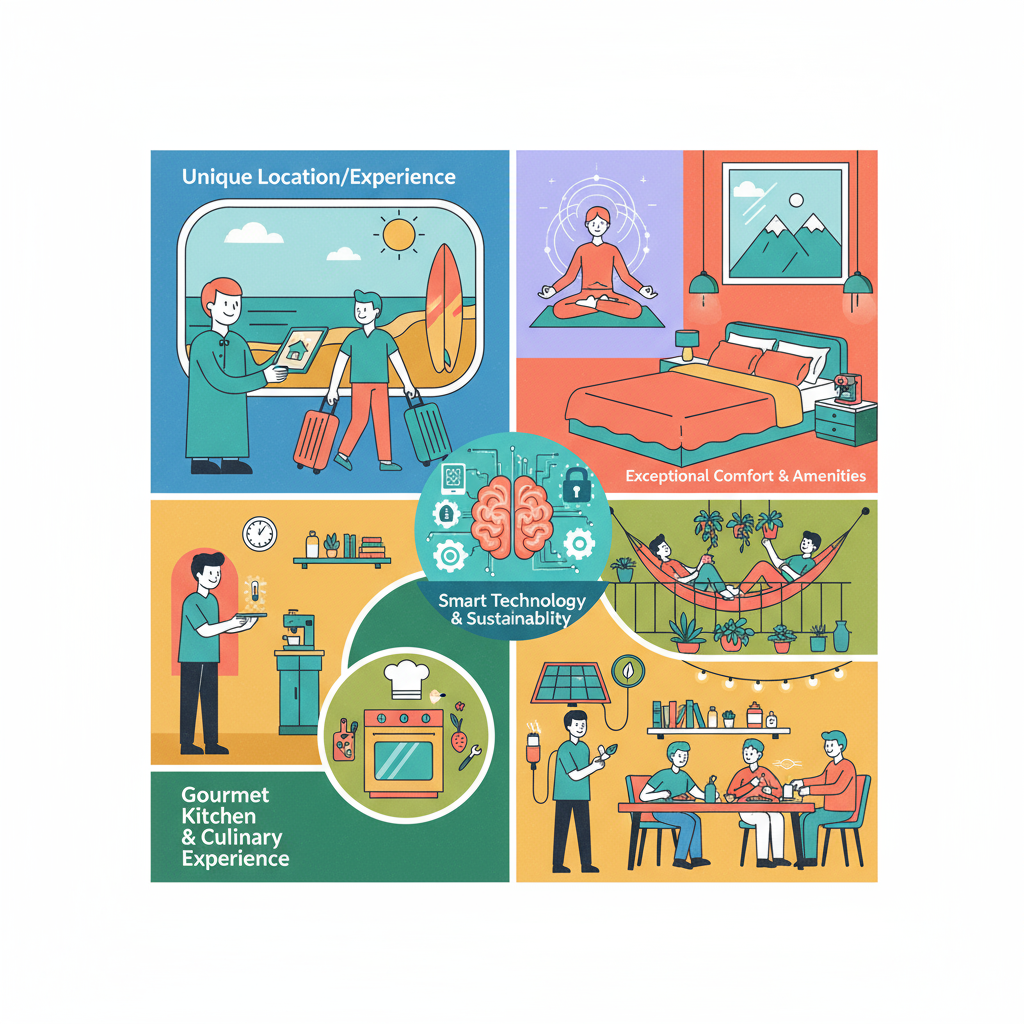Key Takeaways
Research high-demand markets with consistent occupancy rates and favorable STR regulations before purchasing
Secure appropriate financing through conventional loans, DSCR options, or equity-based funding with solid projections
Implement operational systems for listing management, pricing, and compliance to maximize ROI from day one
In the right markets, buying an Airbnb can outperform long-term rentals on both cash flow and appreciation. For operators managing multiple short-term rentals (STRs), expanding your portfolio with the right Airbnb property is an effective way to future-proof your business.
The demand for vacation rentals has shifted post-pandemic, and the way people travel (and work) has changed for good. More professionals are working remotely, staying longer, and booking entire homes in niche destinations. This trend has pushed STR occupancy rates to outperform many hotel markets, opening the door for higher revenue potential and better return on investment, given the property is positioned correctly.
Competition has grown too. Success depends on selecting the right property, understanding local regulations, and having the operational systems in place to scale without breaking your team or burning out stakeholders.
That’s where a clear, efficient plan makes all the difference.
Step 1: Locating the Right Market
Successfully purchasing an Airbnb in 2025 starts with finding the right market.
Some locations bring in steady demand, strong pricing, and fewer headaches. Others? They look good at first glance but fall apart in the fine-print: low occupancy, off-season crashes, or zoning rules that make short-term rentals nearly impossible.
Tourism data and seasonality patterns can't be ignored. Look for cities or regions with consistent visitor traffic throughout the year, not only during holidays or school breaks. Destinations with dual-season appeal (think mountain towns with hiking in the summer and skiing in the winter) tend to support stronger year-round revenue. Business travel hubs and convention cities also offer dependable weekday bookings. When demand is spread out over more months, fewer price cuts are needed to stay competitive.
Emerging markets offer more upside, but also more uncertainty. Established vacation spots come with baked-in demand but often stricter rules and higher prices. Both can work, depending on your strategy. What matters is how the numbers line up with your goals.
Reviewing demand and pricing
Average daily rates (ADR) and occupancy rates are the key numbers to track. High nightly rates won’t help if no one books. Staying fully occupied won’t pay off if pricing is too low to cover costs. Strong markets usually show a healthy mix of both consistent bookings and solid pricing even during shoulder seasons.
Use data tools like AirDNA to compare ADR and occupancy across cities, neighborhoods, and even zip codes. Don’t stop at averages. Look at RevPAR (revenue per available rental), booking lead times, and how performance shifts throughout the year. A property in a downtown core might outperform a beachside listing during winter, but the pattern could flip in summer. These shifts matter when you're trying to scale across multiple units.
You also need to check for saturation. A high number of listings combined with flat or declining occupancy could mean the market has probably cooled. On the other hand, a smaller number of listings with rising demand might signal an opportunity.
Checking short-term rental laws
Before making an offer on a property, check if short-term rentals are even allowed in the area. Many popular cities now limit or ban STRs outright, especially in residential zones. Some require the owner to live on-site. Others cap the number of nights per year or require a lottery system for permits.
Here’s what to verify upfront:
Zoning rules: Some cities only allow STRs in commercial or mixed-use areas. Even in tourist-heavy regions, residential zones often have limits.
Permit and license requirements: Local governments may ask for a short-term rental permit, a general business license, or even both. Some have waiting lists or annual caps.
HOA or building restrictions: Condo associations and gated communities often ban rentals under 30 days. Some allow STRs but charge hefty registration fees or require special insurance.
Call the planning department. Read the municipal code. Check HOA bylaws if you’re buying into a managed community. Don’t rely on what the listing agent or current owner says. Regulations can shift quickly, especially in markets where short-term rentals have grown fast.
Compliance can't be overlooked.
Enjoy the confidence & focus you need to scale your vacation rental business
Book more while doing less
With a reliable VRM solution you can trust, Uplisting can help you grow your business without wasting time on double bookings, unhappy guests, upset clients and worrying what could go wrong next.
Step 2: Secure Your Financing
Lenders aren't just handing out money for short-term rentals without a solid plan.
They want numbers, a clear roadmap, and proof the property can carry its own weight. Interest rates fluctuate, underwriting keeps changing, and most banks are no longer impressed by vague promises of future bookings. When you show a property that performs, with reliable STR data and a well-organized operating model, you're in a stronger position to buy the next one.
Estimating upfront costs
Many operators focus only on the property price. That’s just the starting point. Once you dig into the numbers, the real costs become clearer:
Down payment: Most lenders want 15% to 25% upfront for non-owner-occupied properties. Some push higher depending on market volatility or loan type.
Closing costs: Expect to pay 2% to 5% of the loan amount. That covers lender origination fees, title insurance, attorney review, and local transfer taxes if applicable.
Renovations and upgrades: Paint, flooring, lighting, and safety improvements like GFCI outlets or egress windows often fall outside budget (until they don’t). Build in a 20% cushion for surprises.
Furniture and appliances: A short-term rental needs more than a mattress and a microwave. Think blackout curtains, durable seating, cookware, Wi-Fi routers, smart locks, and a backup set of linens.
Insurance: Standard homeowners policies leave gaps. STR-specific insurance adds liability protection, covers guest-related damage, and meets platform requirements. It costs more, but skipping it isn’t worth the risk.
Budgeting for everything upfront avoids last-minute borrowing or delayed launches. A property that sits empty while waiting on furniture or permit approval drains cash and delays ROI.
Exploring lending options
Not every lender understands short-term rentals. Some still underwrite as if you’re buying a long-term single-family rental. Others now offer products built specifically for STR operators, as long as the projections are solid and documentation is clean.
Conventional loans: These work for some second homes and investment properties, but lenders often require strong personal income and credit. Rates are higher than primary residence loans, and DTI limits are tighter.
DSCR loans: These are loans based on the property’s income—not yours. Lenders look at whether the rental income covers the loan payments, usually aiming for a DSCR of at least 1.2. These work well if you’ve scaled past traditional lending caps.
Private funding: Hard money lenders, investor partnerships, or syndicates can move quickly. They often accept higher risk but charge more. Terms tend to be shorter, and rates reflect the speed and flexibility.
Equity-based options: A HELOC or cash-out refinance on another property offers flexibility without adding more partners or lenders to the mix. This route works well for operators with existing rental equity.
Lenders want to see expected income from the property, ideally with comps and STR projections to back it up. Don’t just say the market is strong. Show it. Include ADR, occupancy rates, estimated operating expenses, and any local restrictions that affect availability. When the financials speak clearly, lenders listen.

Step 3: Operational Setup
Getting the keys to your new Airbnb property is just the start.
Turning that property into a high-performing short-term rental means building systems that hold up under pressure and scale without breaking your calendar, your team, or your reputation.
Start with a listing that reflects what guests actually experience. Developing a consistent brand isn’t limited to logos or color palettes; you need to think about things like tone, expectations, and pricing that match across every booking platform. If one description reads like a boutique hotel and another sounds like a Craigslist sublet, guest trust drops. Use the same language in every listing, photo caption, and house rule.
Guests notice when everything aligns. They also notice when it doesn’t.
Organizing daily management
Juggling tasks across six or more properties without structure turns into late check-ins, missed cleanings, and frustrated guests. Teams can’t rely on memory or scattered spreadsheets to stay on top of everything.
Automated messaging sends the right note at the right time. Check-in info, Wi-Fi instructions, mid-stay updates, and review requests can all be scheduled in advance without manual work. A synced calendar across platforms keeps bookings organized and prevents double-bookings. When everyone from cleaners to guest support works in the same system, you don’t need endless texts or last-minute phone calls.
Tools like Uplisting handle that coordination in one central place. Messages, booking calendars, cleaning schedules, and task assignments stay synced without toggling between five apps. You can assign roles, set rules, and hand off work without losing control.
Optimizing revenue
Filling nights isn’t enough. Pricing and upsells shape how much each booking actually earns. Dynamic pricing tools adjust rates based on demand, season, and local events so you’re never stuck at one rate while the market surges. Instead of reactive discounts, prices shift in real time to stay competitive and profitable.
Channel management expands reach across Airbnb, Vrbo, and direct booking sites without calendar mix-ups or inconsistent pricing. Guests who only book through one site still find your listing, and rates stay aligned by default. More visibility, fewer errors.
Upsells add revenue without extra nights. Guests often pay more for early check-in, late checkout, pet stays, or curated extras like wine pairings or beach gear. These upgrades offer convenience without complicating operations.
For anyone figuring out how to purchase an Airbnb in 2025, buying the property is just the beginning. Running it well, every single day, is what sets high-performing portfolios apart.
Create 5-star guest experiences
Give your guests unforgettable experiences
With Uplisting, you can send the right messages at the right time on all booking sites. Read and respond to guest messages in a single, unified inbox — whether you’re at the office or on the go.
Understand the Risks and Red Flags
Short-term rentals can bring solid returns, but not without friction. A packed calendar only works if nightly rates hold steady. Lower prices may keep bookings coming in, but they also chip away at profit (especially once cleaning costs, taxes, and platform fees come into play).
Markets can shift fast. Local governments often change course with little notice, adding permit caps, new registration systems, or outright bans. Even areas that once encouraged short-term rentals can reverse direction after a few complaints or a change in leadership. Buying a property without checking the political mood in the neighborhood leaves your investment exposed.
Oversupply creates another problem. High occupancy might look promising on paper, but a flood of new listings can drag down rates quickly. When RevPAR drops, guest quality often follows. Look for early signs: shorter booking windows, more price cuts, and an uptick in hosts leaving the platform. If the market feels crowded, it probably is.
Mitigating seasonal fluctuations
Some properties shine for a few months, then sit empty the rest of the year. A mountain cabin fills up during ski season but struggles in summer. A lakefront home pulls in July bookings, then goes quiet by October. Seasonal demand swings make forecasting tricky, and missing the mark can stall cash flow for months.
Market research helps fill the gaps. LTM (last twelve months) RevPAR shows how a property actually performs across the calendar, not just during peak weeks. Pay attention to who books during slower seasons. Travel nurses, digital nomads, and corporate travelers often extend the booking curve beyond traditional vacation windows.
Once the patterns are clear, adjust your strategy:
Use dynamic pricing: Let rates respond to real-time demand, not last year’s average.
Run seasonal promotions: Offer midweek discounts or perks for longer stays when demand dips.
Tailor listing content: Focus on fireplaces, hot tubs, and indoor features in colder months. Highlight patios, trails, and lake access in spring and summer.
Planning around seasonal shifts keeps revenue consistent and avoids the trap of relying on discounts to fill empty weeks.
Staying compliant
To risk sounding like a broken record, the importance of staying compliant can't be understated.
Short-term rental rules change more often than most hosts expect. What worked last year might not pass inspection today. Keeping up matters, especially when scaling across multiple cities or regions.
Start with local taxes. Many municipalities require occupancy, lodging, or sales tax. Some platforms handle collection, but others leave it to the host. Either way, the responsibility falls on the property owner. File quarterly, save every receipt, and track each payment. Tax audits don’t care if the platform dropped the ball.
Check zoning laws and license requirements twice a year. Bookmark your local government’s STR page and skim city council agendas for proposed changes. If the area adds a permit process, shortens allowed stays, or limits the number of STRs per block, those details can directly impact operations.
Keep an eye on platform updates, too. Policy changes around guest screening, refund rules, or listing transparency can affect how your properties perform. Adjust policies early, not after problems start.
Strategies to Scale
Expanding to more properties doesn’t have to mean more chaos.
A solid setup—built on automation, clear systems, and real-time insights—keeps everything running smoothly even as the number of listings grows. Guesswork gets expensive fast. When you’re managing multiple properties, every delay, every misstep, every missed booking window eats into your margins.
Automation helps you stay ahead. Pricing adjusts automatically. Guest messages go out on schedule. Cleanings line up without back-and-forth texts. Everything keeps moving whether you're online or not. That’s what scale looks like when the right tools are in place.
Build around real partnerships
No system runs well without the right people behind it. A cleaner who shows up on time, a co-host who knows the routine, a handyman who doesn’t vanish after one job: those are the people who hold your operation together.
Start with clear expectations. Create checklists for turnovers, maintenance, and guest prep. Pay on time. Offer feedback. Treat every vendor like a partner, not a backup plan. A well-trained team reduces last-minute calls and guest complaints. That’s the difference between running five listings and running ten without losing your weekends (or your sanity).
Centralize, then expand
Managing bookings across platforms gets messy fast.
One double-booked calendar, one missed guest message, or one forgotten clean can lead to a sudden drop in your Airbnb's rating. A central dashboard helps cut that noise. You see bookings, messages, cleanings, and revenue in one snapshot. No more toggling five tabs to find one answer.
Data shows you where to improve. Which property underperforms midweek? Where are reviews slipping? Which listing takes longer to turn over? Real numbers help you make better calls whether you're adjusting pricing, updating photos, or rethinking how you market a listing.
Operators ready to streamline can sign up for Uplisting and bring everything under one roof. It’s built for short-term rental managers who need speed, structure, and fewer surprises.
Buying an Airbnb in 2025 is an effective play when done with clarity, data, and the right systems in place. With the right tools, you can streamline repetitive tasks, maximize revenue, and deliver consistent guest experiences across every property.
Sign up for Uplisting to streamline your vacation rental management and get the tools you need to scale with confidence.
So automatic, you won’t know what to do with yourself
Put my rentals on autopilot
It’s simple to automate repetitive tasks with Uplisting's short-term rental software. You’ll save hours every week and eliminate human error. Go ahead — take some time off.
FAQs About Purchasing an Airbnb in 2025
Do I need a special license for an Airbnb?
In most areas, yes. Many cities require a short-term rental license or registration that goes beyond a standard business license. Some tie approvals to zoning laws, others ask for safety inspections, and a few limit how close rentals can be to each other. The easiest way to stay compliant is to go straight to the city or county website and look for short-term rental rules. A call to the local planning office can also accomplish this.
How do I handle taxes for a short-term rental?
You’re responsible for both local and federal taxes. Most cities collect occupancy or lodging taxes. Some platforms handle that automatically, but many don’t. When they don’t, you’ll need to register with the city or state and pay directly. On the federal side, short-term rental income often counts as self-employment income unless someone else operates the property under a long-term lease. That means filing a Schedule C and paying self-employment tax along with income tax. It’s straightforward once the setup is done, but skipping steps can cost you later.
Can I buy an Airbnb with no money down?
It’s possible, but you’ll need to get creative. Traditional lenders rarely offer zero-down options, so many buyers turn to seller financing, lease options, or partnerships where one person brings capital and the other manages operations. Another common route is pulling equity from an existing property with a HELOC or cash-out refinance. No-money-down deals only work if the numbers make sense. Changing how you structure the purchase doesn’t change whether the property can carry itself. If you’re serious about how to purchase an Airbnb without a large upfront investment, make sure the deal works from day one.
Are returns guaranteed when purchasing an Airbnb?
No. Even in high-demand markets, returns shift with occupancy, pricing, and how well the property runs. Local laws can change, guests can cancel, and competition can drive rates down. Profit comes from smart operations, solid guest experiences, and keeping up with local demand. A strong start helps, but staying profitable means adjusting when the market does.

















.png)

